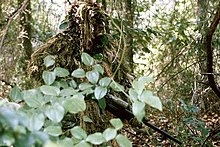Camuflatge

El camuflatge és el mètode que permet als organismes o objectes que d'altra forma serien visibles romandre indistingibles de l'entorn que els envolta.[1] Alguns exemples del camuflatge són les ratlles del tigre i l'uniforme del soldat modern.
La paraula camuflatge prové del francès camouflage, format el 1914 en medis militars a partir del verb italià camuffare ('ocultar, disfressar'). A la natura es parla de mimetisme.
Camuflatge militar
[modifica]En el món militar, el camuflatge és la tècnica de disfressar objectes, vehicles o tropes tot mimetitzant-los amb el terreny circumdant per tal d'ocultar-los a la detecció i identificació de l'enemic, sigui cobrint-los amb xarxes, vegetació, etc., sigui pintant-los o imprimint-los amb dissenys disruptius multicolors.[2]
En el camp específic de l'uniforme militar el camuflatge comença a aplicar-se en entreguerres i es desenvolupa durant la Segona Guerra Mundial i, més encara, durant la guerra freda, però gairebé sempre circumscrit a forces d'elit. Entorn de 1990 el camuflatge es generalitza com a forma bàsica d'uniforme de campanya en la majoria d'exèrcits.
Referències
[modifica]- ↑ «camuflar». Diccionari descriptiu de la llengua catalana. [Consulta: 26 febrer 2017].
- ↑ Maynard, Christopher. Máquinas de Guerra. Madrid: S M, 1979, p. 30. ISBN 84-348-0722-X.
Bibliografia
[modifica]- Behrens, Roy R. (2002). False Colors: Art, Design and Modern Camouflage. Bobolink Books. ISBN 0-9713244-0-9.
- Behrens, Roy R. (2009). Camoupedia: A Compendium of Research on Art, Architecture and Camouflage. Bobolink Books. ISBN 978-0-9713244-6-6.
- Behrens, Roy R. (editor) (2012). Ship Shape: A Dazzle Camouflage Sourcebook. Bobolink Books. ISBN 978-0-9713244-7-3.
- Forbes, Peter (2009). Dazzled and Deceived: Mimicry and Camouflage. Yale University Press. ISBN 978-0-300-17896-8.
- Goodden, Henrietta (2009). Camouflage and Art: Design for Deception in World War 2. Unicorn Press. ISBN 978-0-906290-87-3.
- Latimer, Jon (2001). Deception in War. John Murray. ISBN 978-1-58567-381-0.
- Newman, Alex; Blechman, Hardy (2004). DPM – Disruptive Pattern Material: An Encyclopaedia of Camouflage: Nature, Military and Culture. DPM. ISBN 978-0-9543404-0-7.
- Stevens, Martin; Merilaita, Sami (2011). Animal Camouflage: Mechanisms and Function. Cambridge University Press. ISBN 978-0-521-15257-0.
- Wickler, Wolfgang (1968). Mimicry in plants and animals. McGraw-Hill. ISBN 978-0-07-070100-7.
Vegeu també
[modifica]Text is available under the CC BY-SA 4.0 license; additional terms may apply.
Images, videos and audio are available under their respective licenses.
